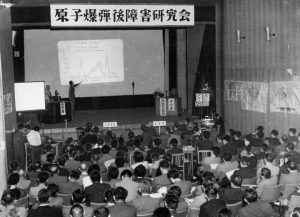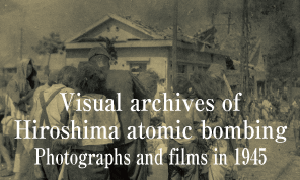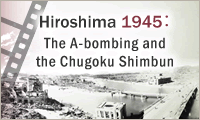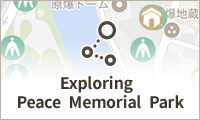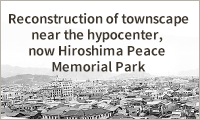Documenting Hiroshima 80 years after A-bombing: In June 1959, research group studying late effects of A-bombings holds first workshop
Apr. 1, 2025
Group attempts to find effective medical treatments
by Maho Yamamoto, Staff Writer, and Kyosuke Mizukawa, Senior Staff Writer
On June 13, 1959, a two-day workshop of a research group studying the late effects of the atomic bombings held its first meeting at Hiroshima City’s Peace Memorial Hall (in the city’s present-day Naka Ward). The event was hosted by the Hiroshima Atomic Bomb Casualty Council, which consisted of local physicians, and the Hiroshima City and Hiroshima Prefectural governments. Around 300 physicians and researchers from throughout Japan made presentations and exchanged opinions at the workshop.
Analyses of symptoms and more
According to an articled published in the Chugoku Shimbun at that time, the gathering was a “comprehensive scientific workshop” where experts from varied fields got together and considered the medical effects unique to the atomic bombings, caused by a combination of the bomb blasts, thermal rays, and radiation. In addition to analyses of the symptoms frequently observed among A-bomb survivors and their root causes, the gathering aimed to uncover effective medical treatments.
In the morning on the workshop’s first day, Tomin Harada, a local surgeon in Hiroshima, gave a lecture on treatments for keloids, which were burn scars observed in A-bomb survivors and marked by excessive scar-tissue inflammation. Compared to the keloids seen in other general burn patients, Mr. Harada reported in his talk that survivors’ keloids had a high rate of recurrence even after skin-graft surgery. “This is thought to have been caused by an effect specific to the atomic bombings,” he reported.
Mr. Harada had been discharged from the military in March 1946 and later opened a private medical clinic in the area of Hirose-machi (in Hiroshima’s present-day Naka Ward) in November. Relying on his experience as a military physician and on information from overseas scientific publications, he started treating patients suffering from keloids and scar contractions. In 1948, he began holding Saturday study sessions with other like-minded private physicians with the aim of learning about medical care for A-bomb survivors. In 1955, he visited the United States with 25 female patients who had experienced the atomic bombing, assisting them in receiving treatments at local hospitals in the United States.
Yoshihiro Harada, 88, Mr. Harada’s first son who lives in Hiroshima’s Naka Ward, still remembers the women, who relied on his father and continued to visit his clinic even after undergoing treatment in America. Yoshiro said, “I heard that my father conducted more than 1,000 surgeries over the course of his life.” The keynote address Mr. Harada delivered at the late effects workshop was based on “290 surgeries for around 150 patients” that he had performed until that time and the follow-ups of those patients (hereinafter, based on minutes of his address).
Gensaku Oho, a physician in Hiroshima who was one of the participants in the Saturday study sessions, also spoke on stage on the first day of the workshop. In 1956, Mr. Oho had published an article in a medical journal in which he announced for the first time that, “The mortality rate for cancer among A-bomb survivors exceeds the national average.” His paper was the forerunner of similar future research. He had scrutinized around 11,400 death certificates that the city government had collected during the period 1951–1955 and gathered information from other sources such as bereaved family members and medical institutions.
“Empathy should come first”
On the day of the gathering, the high mortality rate from cancers for A-bomb survivors was explained again from a statistical perspective. Mr. Oho mentioned that A-bomb radiation “confers an unclear factor that could lead to malignant neoplasms in the future,” adding that, “While too late now, I cannot help but be horrified at the radiation emitted by atomic and hydrogen bombs and the ‘ashes of death’ that result.”
The workshop was also attended by Raisuke Shirabe, a professor at the Nagasaki University School of Medicine who was engaged in treating A-bomb survivors in Nagasaki. Masao Tsuzuki, professor emeritus at the University of Tokyo and specialist in radiological medicine who played a key role in medical surveys that were conducted in Hiroshima soon after the atomic bombing, also spoke at the workshop. Regarding future investigations, Mr. Tsuzuki made an appeal to the audience. “A-bomb survivors have been so harmed for such a long time and, above all, still face days of uncertainty. We therefore must first and foremost treat them with empathy and compassion.”
At the workshop’s closing ceremony, Susumu Watanabe, a professor at the Hiroshima University School of Medicine who also served as chair of the workshop, delivered a closing address. “Needing to consistently study the late effects of the atomic bombings, I hope we can all work together to hold a second workshop next year.” The following year, a workshop was held in Nagasaki and, ever since, workshops have been held alternately in the two A-bombed cities. Even as some medical effects from the atomic bombings remain unknown, the 65th such workshop will be held in Hiroshima this year.
(Originally published on April 1, 2025)

